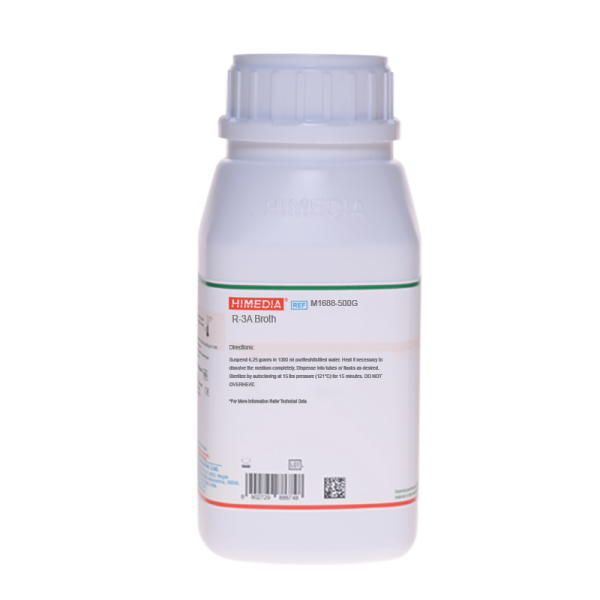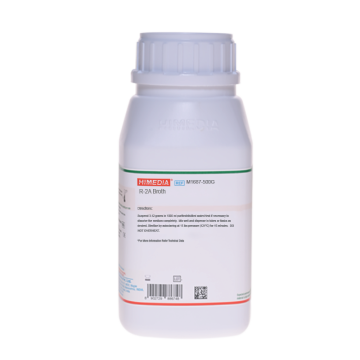 Your enquiry has been submitted
Your enquiry has been submitted
R-3A Broth
R-3A Broth is recommended for sub culturing microorganisms from potable water.
Composition**
| Ingredients | Gms / Litre |
|---|---|
| Casein acid hydrolysate | 1.000 |
| Yeast extract | 1.000 |
| Biopeptone | 1.000 |
| Dextrose | 1.000 |
| Starch soluble | 1.000 |
| Dipotassium phosphate | 0.600 |
| Magnesium sulphate anhydrous | 0.048 |
| Sodium pyruvate | 0.600 |
Final pH ( at 25°C) 7.2±0.2
**Formula adjusted, standardized to suit performance parameters
Directions
Suspend 6.25 grams in 1000 ml distilled water. Heat if necessary to dissolve the medium completely. Dispense into tubes. Sterilize by autoclaving at 15 lbs pressure (121°C) for 15 minutes. DO NOT OVERHEAT.
Principle And Interpretation
The total bacterial count of drinking water is determined by plate count on a nutritionally rich medium. However all organisms present are not able to grow on them, either because they are slow growers or because they cant grow on that media (1). For this reason a nutritionally reduced medium was described. R-2A Agar is a modification of this medium (2,3).
Many bacteria from natural waters, which contain limited nutrients at ambient temperature, grow best on the media with less nutrient levels. They grow better at the temperatures below the routine laboratory incubation temperatures of 35 to 37°C (3).
R-3A Agar is a subculture medium which is used to subculture the organisms recovered on nutritionally deficient R-2A Agar (1). R-3A Broth is similar in composition to R-3A Agar, except agar.
These media contain casein acid hydrolysate, yeast extract, biopeptone as source of essential growth factors required for metabolism of the bacteria. Dextrose is the energy source. Starch acts as a neutralizer that neutralizes any toxic metabolites, if present. Phosphate buffers the medium while sodium pyruvate supplies additional nutrition. Magnesium sulphate serves as a source of ions. Due to the presence of the above mentioned ingredients these media allow the growth of stressed and chlorine tolerant bacteria present in treated waters.
Quality Control
Appearance: Cream to yellow coloured homogeneous free flowing powder
Colour and Clarity of prepared medium: Yellow coloured clear solution in tubes
Reaction: Reaction of 0.625% w/v aqueous solution at 25°C. pH : 7.2±0.2
pH: 7.00-7.40
Cultural Response: M1688: Cultural characteristics observed *by using standard ATCC cultures after an incubation at 35-37°C for 24-72 hours.
| Organism | Inoculum (CFU) | Growth |
|---|---|---|
| Candida albicans ATCC 10231 | 50-100 | good-luxuriant |
| Enterococcus faecalis ATCC 29212 | 50-100 | good-luxuriant |
| Escherichia coli ATCC 25922 | 50-100 | good-luxuriant |
| Salmonella Enteritidis ATCC 13076 | 50-100 | good-luxuriant |
| Salmonella Typhi ATCC 6539 | 50-100 | good-luxuriant |
Storage and Shelf Life
Store below 30°C in tightly closed container and the prepared medium at 2-8°C. Use before expiry date on the label.
Reference
- Reasoner and Geldreich, 1985, Appl. Environ. Microbiol., 49:1.
- Stark and McCoy. 1938. Zentralbl. Bacteriol. Parasitenkd. Infectionskr. Hyg. Abt.2 98 : 201
- Collins and Willoughby, 1962, Arch. Microbiol., 43:294.
| Product Name | R-3A Broth |
|---|---|
| SKU | M1688 |
| Product Type | Regular |
| Physical Form | Powder |
| Origin | Animal |
| Packaging type | HDPE |
| References | 1.Reasoner and Geldreich, 1985, Appl. Environ. Microbiol., 49:1.2.Stark and McCoy. 193 |
| Customized Product Available | No |





